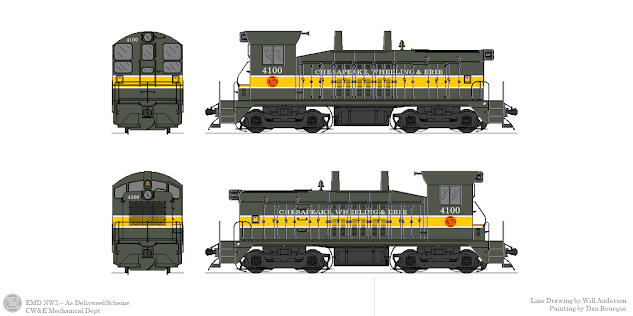Talk about a project that was completed in fits and starts, these two gons take the cake. Many years ago, I purchased a Concor 52'6" gondola kit that included steel coils, coil troughs and hoods. Somewhere along the line I found another one, probably at a train show. I had always intended to build these for the home road and paint them in a similar scheme to those found on the C&O/B&O/Chessie System in the 1970's. The photo below shows how Chessie marked these cars especially for coil service. In addition to the two yellow panels on the side and the "COILS ONLY" stencils, the interiors of the cars were painted yellow. This was supposed to help alert crews and shippers to the special loading requirements.
So this past May, I took the kits to Michigan with the intention of building them over the summer. I had built one of these kits before for general service, and I remembered that the underbody had to be modified in order to lower the trucks. And lowering the trucks meant changing the coupler pockets and end sills. There was a great article many years ago on how to do this, but of course I couldn't find it. So I looked at the bottom of the one I had built previously in order to figure out what needed to be done.
So I started hacking away at the bottom of the car. I knew it wasn't going to be pretty, but I wasn't building this for a contest and no one was ever going to see the bottom of it anyway. The photo below shows the modifications to lower the trucks and raise the coupler pockets.
The next step was to glue the underframe pieces to the body. Armed with a few clamps and some wood blocks, the next step was easy.
As I was working on the underframe, I was also looking at the sides and ends and trying to determine what needed to come off and be replaced with some finer detail. It soon became apparent that just about everything had to come off. About this time, I began to wonder why I was spending all this time hacking away on a kit that was at least 30 years old and lacked all of the finer detail that's available on RTR stuff today. I was about to throw in the towel when I came across the photo below.
The picture taken by Steven Brown shows Clarke Avenue Yard in Cleveland on the old B&O. What caught my eye was the gon behind the switcher. Note the yellow interior- this is clearly one of the coil gons and it's in pretty good shape. And while it is difficult to see in this photo, the car has ladders on the right side. I had been working on a resin kit of a SOU gon and it had ladders on all the corners. So it occurred to me that I could use ladders instead on grabs on the corners. And there was the additional inspiration I needed.
Next up, I carved off most of the detail and added new ladders and stirrup steps. I also added some etched walkways pieces to the solid platforms by the handbrake. As I wanted the cars to be able track well while empty, I also added some shot to the bottoms. Remember- I said that no one was going to see the bottoms! The photo below shows the cars at this point.
With the cars complete, I now turned to the hoods and troughs. My efforts here didn't last long as it became apparent that the hoods would require major work. In addition to adding grab irons all around, the braces for the top that came with the kit weren't going to work. I started looking through kits I had on hand and online but couldn't find anything that would work. I really didn't want to scratch-build these, but I was too far into this project to turn back. So the cars sat for awhile.
Sometime later, I came across a photo of the B&O gons with a caption that said these cars were rebuilt for hot coil service and as such, didn't have hoods. Bingo! That was exactly the inspiration I needed to finish these up. I dug through my coil car photos and found the one you see below.
A cradle like the one in the gon would be easy enough to build out of styrene shapes. A quick search through my supplies yielded exactly what I needed. So the last piece of the puzzle for these two cars was finally in place!
Several trips through the paint shop, some home road decals, and this project was finally complete. The cars received light weathering as they were rebuilt in September of 1975. The photos below show the final results.
So why did I do this? Several reasons. First, I had always wanted to have a couple of coil gons like these decorated for the home road. Second, I still enjoy taking some of the old standards and making something somewhat acceptable out of them. And lastly, one of the really neat things about proto-freelancing is that you can come up with rolling stock like this. While there's no specific prototype for the car, it is based upon prototype principles and practices. And hopefully, I've followed those closely enough to make it appear as thought there could have been prototype for it.




















